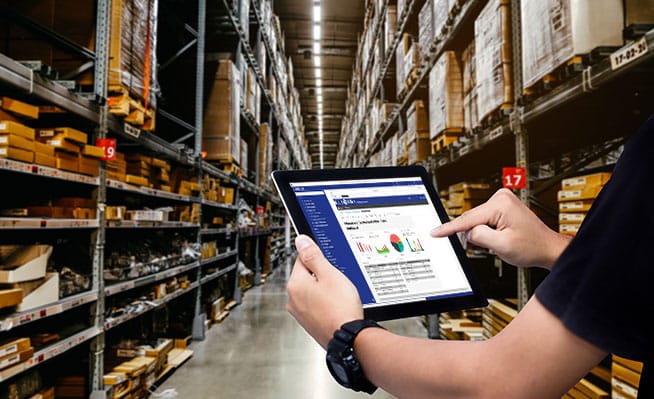Typically, inventory management techniques are developed with a particular market in mind. This implies that your specific business requirements should be taken into account while deciding on the best simple inventory management software. The best inventory management software will simplify routine tasks and provide useful insights. This may be achieved with the help of an effective inventory simple management system, which can also protect your small business from overspending on features it doesn’t need. In this article, we will talk about simple inventory software that is free and can be used with a barcode scanner. Read on!
What Is a Simple Inventory Software?
Simple inventory management software is a cloud-based service that lets you keep tabs on your stock, plan for sales, and monitor product availability.
These cloud-based services provide a wealth of features at no cost. Companies that also provide premium tiers typically offer free inventory management software as their base or freemium plan. What this means is that there is potential for expansion in the software as your company expands and new features become necessary.
Currently, over 700 businesses in at least 60 different countries use Simple Inventory software as their primary quality assurance tool. Users can have more control over dynamic business settings because of the streamlined features and centralized interface. There’s a free version, but if you want all the bells and whistles, you’ll have to pay once.
Furthermore, the best inventory management software, whether used alone or in conjunction with a point-of-sale (POS) system, should make it simple for companies to monitor their goods and equipment from the time they are first acquired to the time they are finally sold.
How Do You Create a Simple Inventory Software?
Organizations need to be able to swiftly respond to shifting market conditions while still maintaining sufficient inventory levels to satisfy monthly client demand. A simple inventory management software solution can be quite useful for businesses that have recently experienced an increase in their inventory requirements. Here are simple steps on how to create one.
#1. Conception
First, examine the day-to-day operations of your company and single out the key functional areas that are involved and amenable to data tracking. The next step is to research comparable software that has already been implemented by other businesses in your sector. Find the manual steps in your own processes that could be replaced by automated ones. If you want to find answers to your challenges, you need to first identify those needs.
#2. Aims of a Business
Do you plan on employing an IMS as part of a larger e-commerce strategy, or do you wish to create software specifically for managing the storage and distribution of fresh stock? At the outset, you should define your primary objective and any business targets you may have. Make sure you understand the intended use cases, and do your best to meet them.
Specific applications could include saving money on a stock, making more money, resolving a pricing issue, making customers happier, etc. It is crucial that you be able to explain how your product will affect each of these criteria individually. Most importantly, it is critical to convey these objectives to the team in a clear and concise manner throughout the onboarding phase.
#3. Software Development and Testing
Writing code for the software’s application and any supplementary tools and libraries is often the next step once requirements have been specified. Engineers are responsible for more than just writing code; they must also test it thoroughly to catch and fix any issues before putting it into production.
In this stage, the software is iterated upon and modified several times so that it functions as planned and may be improved upon by other programmers. Maintaining high-quality and regularly updated software also requires documenting the design process. After developing simple inventory management software, the next steps are rolling it out to users and keeping it updated.
Common Features of a Simple Inventory Management Software
Developing a simple inventory management software for your company’s stock is one of the most straightforward tasks you can embark on after you’ve familiarized yourself with the necessary components. Although your needs could be different from mine.
#1. Point-Of-Sale Integration
Retail staff may process payments from customers and monitor inventory with the help of POS systems. Third-party IMSs can be integrated into these systems as well, saving employees the trouble of entering data manually into stock control systems. By connecting your point-of-sale (POS) system to your inventory management software and your e-commerce data sources and store databases, your business may gather more information and make more informed decisions.
#2. Logistics
Your inventory shipment needs to have a location tracking system that updates you instantly. Here, the inventory management software is linked to remote trackers carried by drivers and vehicles. Using this method, you’ll be able to track the precise location of your orders at all times.
There is no doubt that an IMS can improve your company in many ways, not the least of which is inventory management and, by extension, supply chain efficiency.
#3. Forecasting
Envision being able to gauge interest in your wares in advance of stocking shelves. Inventory managers can use statistical models to better plan product launches by anticipating which products will be in the highest demand. Some of these apps even use AI-based capabilities to accomplish this.
#4. Barcode Scanner
A barcode is a special code that is printed on each and every item sold in a store. It’s utilized for inventory management by both the factory and the stores selling the product. When used in conjunction with a barcode scanner, simple inventory management software enables efficient inventory management.
#5. Automatic Re-ordering
The vendor can account for stock on hand, anticipated demand, and other factors that affect cost recovery to achieve maximum efficiency through the use of a cutting-edge feature called Automatic Re-ordering. An IMS might be programmed to keep track of your inventory, determine how many of each item you need, and place those orders on your behalf to ensure you never run out.
#6. Reporting
Businesses rely on IMSs to store, manage, and analyze vast amounts of data. You may use this information to generate reports that show you how well your inventory is doing compared to other assets.
Free Simple Inventory Software
A brief overview of each free simple inventory management software is provided below.
#1. UpKeep
UpKeep is software for managing inventories and keeping tabs on order fulfillment. The platform establishes a unified database for tracking stock levels, making it easy to see at a glance what you have on hand and what needs to be restocked. While this software does not provide a native mobile app, it is web-based and mobile-friendly, making it accessible from any mobile browser.
Furthermore, UpKeep is a free simple inventory management software that is suitable for any e-commerce business, notwithstanding their ‘in-person’ services (such as technician planning and work orders). When inventory gets low, the software will alert you with a push notice and an email. The system also allows you to control many branches. Their specialty is working with manufacturers that have multiple locations so that you may sell finished goods and spare parts over the Internet.
The free plan is great since it includes extensive asset management, which allows you to submit technical docs, photographs, text, and even video content for each product. Using their mobile-friendly interface, you can control stock and track expenditures from anywhere. When an item is added to an invoice or work order, the corresponding update to the inventory count is likewise performed mechanically.
#2. Zoho Inventory
You can keep tabs on stock levels, handle sales and purchases, and advertise your wares on various marketplaces with the help of Zoho Inventory, a cloud-based inventory management service. With this method, you can manage stock for all of your online stores from one convenient location.
In this way, Zoho Inventory helps you maintain consistent stock levels across all of your sales channels by automatically updating the number of available items once a sale is made. The software features built-in routines that automate processes like sales and purchase order processing and tracking shipments.
However, the software’s usage of in-depth dashboards is one of its strongest points. With Zoho Inventory’s intuitive dashboards, you can keep tabs on stock levels and top sellers with ease.
In addition to your own online store, you may also sell your wares on marketplaces like Amazon and eBay with this feature. You’ll be able to easily do business with clients all across the world because of the initiative’s backing of several different currencies.
#3. Sortly
Using Sortly, you can manage your stock, organize your products into categories, and keep tabs on each and every sale that comes in. The software is user-friendly, with an intuitive interface and a layout that works on any mobile device.
Automatic alerts for low stock and date-based reminders for products nearing the end of their warranty or expiration periods are just two of the ways in which Sortly simplifies inventory control. In addition, you can create your own dashboards to receive a high-level overview of your company’s operations.
The free inventory management program only lets you add one custom field. For items that don’t fit neatly into the predefined fields, you can now create a new inventory category. Companies selling innovative or otherwise unconventional goods may benefit from this.
Notable features include the absurd simplicity with which products may be tracked; using Sortly, a company can rapidly and easily build an inventory database complete with pictures, descriptions, and custom fields. In addition, low stock and expiration alerts and reminders can be personalized and set up. The mobile software developed by Sortly helps companies manage their stock wherever they may be.
#4. SalesBinder
If you’re looking for a free, forever edition of simple inventory management software, go no further than SalesBinder. The online software features a pleasant interface that is simple to use and beneficial in terms of stock management.
Among SalesBinder’s many useful features are a customer relationship manager (CRM), limitless storefronts, invoices, estimations, transport tracking, barcodes, sales orders, purchase requests, reports, and an iOS inventory app. Software is modular, so you may piece together an inventory management solution that works for you.
In addition to helping businesses manage their customers and contacts, SalesBinder also contains tools for handling sales orders.
Among its many useful functions is a comprehensive vendor management system that permits monitoring of all outgoing and incoming stock from and to any given vendor. Since inventory management is intrinsically linked to customer relationship management, this bolsters their primary focus. SalesBinder integrates inventory monitoring, shipping, and control with customer information, analytics, and communications.
#5. Stockpile
Stockpile is cloud-based stock management software designed for independent business owners. The software allows you to keep track of supplies at several warehouses, and you can even set up individual users with different roles and privileges.
Furthermore, Stockpile streamlines the process of adding new stock, monitoring sales, and dealing with damaged or returned items. Not all stock management solutions include built-in support for returns, thus this feature deserves special attention when it is present. You can upload as many products and variants as you need to accommodate your expanding business, as there are no limits on stock items in Stockpile. With only one login, you can manage many stores, shelves, brands, and personal preferences.
In addition to the aforementioned benefits, they also offer a robust reporting instrument, which can provide you with invaluable insights into inventory turnover. Stockpile is intended to be used by anyone, thus the developers included a number of tutorials and free assistance for anyone who needs it. Stockpile can handle transactions in several currencies and keep track of sales data. Low-stock alerts can be set up in a variety of ways.
#6. Odoo Inventory
Since its inception, Odoo has attracted more than 7 million users as a free and open-source inventory management software. Toyota, Cox, Hyundai, and Danone are just a few of the organizations in the retail and manufacturing sectors already using them.
Also, Odoo Inventory stands out among similar programs because of its adaptability and wide selection of available customizations and solutions (CRM, e-commerce, accounting, inventory, point of sale, and project management, to name a few). Select the ones you require, or combine them into a comprehensive enterprise answer. Also, read INVENTORY CONTROL MANAGEMENT & SYSTEM: Best Practices.
In addition, Odoo Inventory is an all-inclusive solution for managing and selling stock that, with some effort, can be customized to fit your specific requirements. The extensive documentation, open-source roots, and long list of possible add-ons allow you to tailor it to your own needs. It goes without saying that advanced technical skills are required for anything open source and highly configurable. In-house IT departments are most suited to use Odoo.
Importantly, Odoo Inventory enables just-in-time (JIT) inventory management, which helps companies optimize their inventory levels to decrease waste and boost productivity. You will also have access to barcode scanning, integrated shipping and receiving, a mobile app, and real-time inventory tracking across several locations.
How Do I Manage Inventory in Excel?
Any business selling tangible goods relies heavily on effective inventory management software. Microsoft Excel is a wonderful tool to use if you are just starting out and have a modest number of products without many variations.
It takes effort and careful initial template setup to make the most of Excel for online inventory management. Here is how to manage inventory in Excel.
#1. With Excel Inventory, Avoid Problems and Mistakes
Due to the inherent fallibility of humans, many experts shy away from utilizing Excel for stock management. Unless you know what you’re doing, it’s also tough to spot mistakes in hard data and numerical sheets. The only way to prevent this from happening is to establish a routine of daily reviewing and self-auditing.
#2. Quickly Update
If you want to avoid problems, have everyone who deals with orders promptly update the related Excel document. Even though Excel isn’t a real-time inventory management solution and won’t ever show you the accurate worth of your stock at any given moment, it’s still crucial that you update it as frequently as possible to prevent problems like overselling an item that can’t be restocked.
#3. Embrace the Cloud
Due to its inability to support simultaneous use by many users, offline Excel documents have significant limitations. To facilitate better self-auditing, the incorporation of data from many sources, and the acceleration of processes, using Excel in the Cloud (OneDrive) or Google’s version assures that numerous individuals may be invited to the sheet and modify it at once. It’s convenient since you can make changes on your iPad and then sync those changes to your desktop computer at home.
#4. Focus on Data Consolidation
By compiling your statistics on a monthly basis, you’ll have the raw material for charts that clearly show your sales performance over time. This needs to be done on a monthly and quarterly basis, with special attention paid to major holidays and other special occasions.
The inability to easily evaluate your historical data is a common complaint about Excel, but this problem may be solved by compiling all of your data for the month into a single, readable pivot table. It’s a pain, but keeping track of sales over time and between seasons will help you optimize your stock in the future.
#5. Check the Values
It is up to you to make sure you are tracking and calculating everything that needs to be in order when using Excel as an inventory tracking tool. For instance:
- Have you factored in lead times (time from manufacturer to warehouse or 3PL) when calculating the time to reorder?
- Do you base earnings on total sales, or do you use a per-item profit margin instead?
- Do you instantly factor in inventory when determining sales tax?
- The value of your entire stock depends on whether you plan to sell or keep it.
Verifying the accuracy of the numbers you use in your calculations is a good way to avoid making costly and time-consuming mistakes down the line.
#6. Inspect and Audit
Unless a barcode scanner is integrated into the software, data entry in Excel must be done manually. This will cause mistakes in reordering, underestimating or overestimating earnings, and ultimately throwing off your entire supply and demand.
A policy of keeping track of everything on paper in addition to your Excel document will allow you to review your stock and make any necessary adjustments at the end of each day.
#7. Realize When It’s Time to Improve
Because hundreds of columns are too complex, time-consuming, and difficult to keep track of and up to date, Excel simply does not function with medium to big inventory volume. You should be aware of when it is time to switch to a more advanced inventory management system.
Simple Inventory Software With Barcode Scanner
Here are the top 3 simple inventory software with a barcode scanner.
#1. Cin7 Omni
If your company’s revenue is over $1 million per year, Cin7 should be your automated inventory management software of choice. Cin7 automates order processes and ensures stock levels are always up to date across all of its brick-and-mortar and online sales channels. Business models like Rentals and Asset management are not good fits for Cin7. Also, companies in the retail or wholesale trade use Cin7 to optimize their operations, including maintaining optimal stock levels, profit margins, and cash flow.
Furthermore, With built-in EDI and interfaces to every major e-commerce platform, marketplace, and 3PL, Cin7 Omni is a highly customizable inventory management and order management solution. It outperforms the competition across the board for B2B and B2C warehousing, shipping, and fulfillment. Brands, retailers, and wholesalers can operate more smoothly at scale and with better demand/supply matching thanks to Cin7 Omni’s excellent automation, workflows, reports, and analysis.
#2. Fishbowl
In order to help medium and big organizations deal with demand trends and supply challenges, Fishbowl offers comprehensive manufacturing and inventory control software. Fishbowl is a manufacturing automation platform with capabilities including work order management and production schedule generation.
Also, improve and modernize production using Fishbowl’s suite of tools for managing manufacturing and stock in a warehouse setting. With Fishbowl’s inventory-focused approach, your rapidly expanding company will have more control over expenses and output thanks to strategic automation.
You may make well-informed, timely pricing decisions with the help of Fishbowl’s real-time insights and data collecting, which gives business owners full visibility across the board.
Better automation and integration are what you may expect to gain with Fishbowl. Fishbowl’s solution may be simply linked with popular CRM and business platforms like QuickBooks, Amazon, Adobe, Salesforce, Shopify, and more.
#3. ShipStation
ShipStation is a multi-carrier, multi-channel shipping solution made specifically for e-commerce businesses. However, ShipStation, which is used to power thousands of stores and processes millions of shipping labels every month, helps retailers save time and money by improving shipping efficiency. ShipStation pulls in data from more than 40 different sales channels, applies a set of shipping preferences to each order based on your preferences, processes and prints shipping labels and packing slips (in batches of up to 500), and automatically updates each store with shipping status and tracking information.
Also, Automatic customer communication and centralized reporting are both provided once the label is made. This process is fully automated, smooth, and real-time. If you’re wanting to outsource all or part of your delivery procedures, check out our Fulfillment by Amazon integration.
Does Quickbooks Do Inventory?
With QuickBooks Commerce, you can centralize your sales, inventory, accounting, and operational activities, resulting in a practically assured boost in productivity. QuickBooks Commerce, in contrast to Excel and other simple inventory software, not only collects raw data but also generates automatic intelligence reports that provide clear insights into your company’s strengths and areas for improvement.
As your business and customer base expands, your inventory management software should be able to keep up with the demands of your expanding operations, from optimizing your stock for higher sales and ROI to accommodating new sales locations.
Simple Inventory Software for a Small Business
Overview of Top simple inventory software for a small business.
#1. FreshBooks
Even though it’s most known as an accounting system, FreshBooks also includes basic inventory monitoring for self-employed people and small enterprises.
Even if you simply sell a few products or want to add product sales to your service business, inventory management is still time-consuming and labor-intensive. Especially if you sell through a variety of distribution points.
If you use FreshBooks for accounting as well, it makes sense to utilize it for inventory management as well.
FreshBooks is the ideal option if you’ve never used inventory software before but are curious about the hype. For those who are on the fence about investing in inventory management software, this is a helpful answer.
#2. Veeqo
When it comes to multi-channel selling demands, Veeqo is another popular inventory management software for retail and wholesale businesses. The software claims to be a shipping platform in addition to managing inventory.
Its user-friendly design helps you manage your many sales channels in one place, much like Zoho Inventory. It also has tools for tracking orders, keeping tabs on stock, compiling reports, and managing inventories at a warehouse.
Veeqo’s ability to handle large orders quickly thanks to its built-in barcode scanner sets them apart from the competition. Stock-taking is sped up as a result as well.
Furthermore, the platform has a stellar reputation in the transportation industry. Over 15 major shippers, including UPS and FedEx, are integrated into its shipping system. The portal also includes delivery options including real-time tracking and cheap shipping costs.
While getting set up can take some time, once you are everything runs flawlessly. Because of this, it is the best inventory management software if you need something that can grow with your business, but it is not the ideal choice if you need to get up and running quickly.
#3. Brightpearl
Designed specifically with multi-channel retailers and wholesalers in mind, Brightpearl combines a retail management system with inventory management software. The software can simplify the processes involved in inventory management for businesses. Even on the more expensive plan, you’ll have access to all the essential tools for managing your stock. A cheaper package for organizations with less than 1500 orders each month has far fewer features, though.
Brightpearl’s great feature is that it was developed with huge transaction volumes in mind. If you’re looking to switch away from Stitch Labs, Brightpearl is a great option. Square has acquired Stitch Labs, and the company plans to shut down in the spring of 2022.
Brightpearl’s dedication to improving its inventory management software by releasing frequent updates is commendable, however, these updates often include new flaws that must be worked around.
#4. Netsuite
Oracle’s Netsuite is the top choice for large manufacturers and other businesses with extensive inventory demands.
The software provides purchasing capabilities in addition to standard inventory management software functions, which facilitates streamlined production and distribution.
The inventory management software offers a wide range of configuration options and powerful functionalities. In-depth product catalogs, cycle counts, and demand forecasting are just a few of its sophisticated capabilities. However, you will probably require the assistance of developers to fully utilize its features. It will be worth the effort to set up the platform’s inventory system.
One caveat is that it is not a good fit for companies that have particularly high requirements for retail functionality. Better results can be achieved with the other retail-specific inventory management tools presented below.
#5. Square
Because of its excellent point-of-sale features, Square has topped our best POS, best free POS, best POS system for shops, and best free restaurant POS lists, respectively. However, all POS accounts with Square provide outstanding tools for managing stock levels.
Features including real-time stock updates when sales are made, e-commerce integrations, mobile POS, order management, product variants, and more are included with every Square for Retail account. Square for Restaurants is another product that helps businesses manage their menus, orders, inventory, online orders, deliveries, and more.
Conclusion
Not all free inventory software is created equal. While there are certainly drawbacks to using free simple inventory software, this shouldn’t discourage you from getting the essential tools you need to keep your firm afloat. Zoho is a great option for anyone looking for a cloud-based service. Both inFlow and Odoo have the necessities for managing stock, orders, and the warehouse, plus a few extras.
Of course, if you like, you can use Microsoft Excel to make an individualized stock-tracking solution. Be prepared to put in a lot of time inputting data by hand.
Simple Inventory Software FAQs
What Is the Easiest Way to Keep Track of Inventory?
Physical counts every two weeks and sales comparisons are the most basic stock tracking methods. A term for what you’re describing is “periodic inventory.” In perpetual inventory, a program like BinWise tracks stock and links to your company’s point-of-sale system.
Can I Use Excel to Keep Track of Inventory?
While Excel is easy to use and inexpensive, it has limitations (and errors) that professional inventory management software does not. You can organize and categorize your data in as many columns as you need with the help of a spreadsheet.
Does Excel Have an Inventory Template?
Yes. Personal property template. With the template, you can categorize your stuff, indicate its condition and value, and keep track. This free Excel template is not only a helpful tool for inventory management, but also a great time-saver.
Similar Articles
- BEST APPS FOR INVENTORY MANAGEMENT IN 2023
- Best 15+ INVENTORY SYSTEMS FOR SMALL BUSINESS in 2023 (+ Free Options)
- FREE PROJECT MANAGEMENT TOOLS EXCEL: All You Need to Know
- INVENTORY TRACKING SYSTEM: What Is It, Types & Free Tools






